The 8 Stages of Shooting
 |
|||
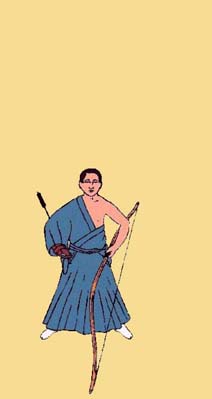
ASHIBUMI
(footing)
Ashibumi is the foundation of good shooting. Without a stable ashibumi, proper shooting is virtually impossible. There are two methods of positioning the feet when making ashibumi: the step and slide method used in reishakei and the two-step method used in bushakei. In both cases it is important to keep the body erect and avoid bobbing or swaying as you move into position. As a rule, the feet are spread the distance of one's arrow length, or yazuka, with the big toes set in line with the target's center. The angle of the footing should be sixty degrees with the weight evenly distributed so that the center of gravity is maintained between both feet. Slight pressure, devoid of excessive tension, is applied to both legs, and the knees are stretched naturally into place. The bow and arrows are held at hip level aimed toward the center line of the body, with the top of the bow held about ten centimeters above the floor.
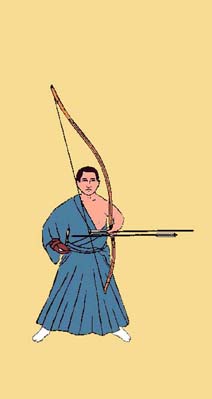
DOZUKURI
(correcting the posture)
Once the feet are set, the posture of the upper body must be aligned accordingly. Special attention must be given to the so-called three-cross relationship, where the shoulders, hips and feet are held in line with one another, parallel to the floor and straight to the target. The spine and back of the neck are gently stretched upwards, but the shoulders are kept flat. The bottom end of the bow is rested on the left knee and held so that the upper curve is in line with the center of the body.
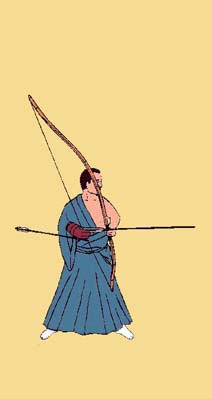
YUGAMAE
(readying the bow)
As mentioned above, there are two styles of yugamae in modern kyudo: shomen no kamae (shown here) and shamen no kamae. Both ways include preparatory movements known as torikake (setting the glove), tenouchi (gripping the bow), and monomi (viewing the target). The explanation for these movements is quite complex and differs according to the influence of style. Here is a basic explanation of these movements.
Torikake: To make torikake hold the glove just below the nocking area on the string and set the string in the groove at the base of the thumb, then depending on whether it is a three- or four-finger glove, lay the first two or the first three fingers across the thumb. Slide the thumb up the string until it meets the arrow. Use a slight inward torque of the hand to hold the arrow in place.
Tenouchi: Keep the hand straight with the fingers extended and held close together. Place the hand so that the outside edge of the grip rests along the line just under the fingers. Fold the last three fingers in to meet the thumb.Do not use the forefinger to grip the bow. It is important to understand that among all the methods of holding a bow tenouchi is unique to Japanese archery. The help of a qualified instructor is necessary to fully understand the technique.
Monomi: Look at the target with calm, half-closed eyes. Monomi is not an aiming technique, it is a method of sending one's spirit to the target before shooting. Once monomi is performed one must not blink or look away from the target.
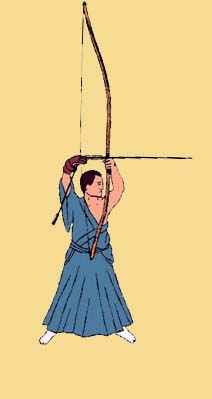
UCHIOKOSHI
(raising the bow)
In the case of shomen no kamae, the bow is raised perfectly straight with the nocked arrow held parallel to the floor. Normally, the bow is raised to a point where the hands are just above the head and the arms are at a forty-five degree angle. The arms and chest are kept relaxed. The shoulders are kept flat as they are stretched forward, toward the bow.
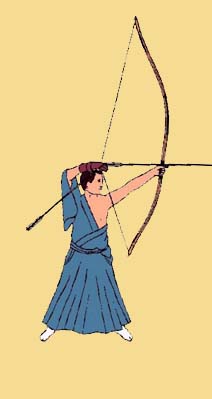
HIKIWAKE
(drawing the bow)
In shomen no kamae there are two stages to the draw. The first, called daisan, is a preliminary move that sets up the full draw of the bow. Daisan is formed by pushing the bow to the left as the right arm folds at the elbow. The arrow is drawn to half its length and the right hand is a little above and just forward of the forehead. In the second stage of hikiwake the bow is pulled into full draw using the muscles of the back and upper arms. Resist the temptation to simply pull the string into place with the right hand while you keep the left arm stiff. The draw of a Japanese bow is more an action of spreading it apart evenly to the left and right.
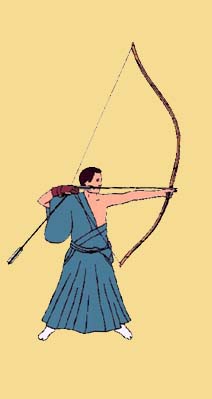
KAI
(completing the draw)
Kai means "Meeting." The term is used in kyudo to show that each of the previous stages of shooting combines to form kai. The release is a natural result of their meeting. The success or failure of the shooting is not determined after the release, it is determined in kai. It is said that kai holds the essence of kyudo. If hikiwake is the physical draw then kai is its spiritual complement.
Included in the moment of kai are two internal actions; tsumeai and nobiai. Tsumeai is a physical expansion of the spine and skeletal structure that keeps the bow drawn at optimum length, while nobiai is more of a mental or spiritual expansion to keep the body from giving in to the tension of the bow. As with many aspects of Kyudo, these techniques require a qualified instructor to fully comprehend.
 |
||
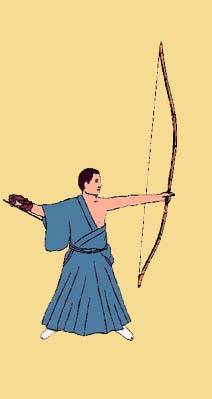
HANARE
(the release)
If kai holds the essence of kyudo, then hanare reveals its mystery. Hanare has been compared to the moment when flint and iron combine to create a spark, or to when snow falls under its own weight from a leaf. Most teachers suggest that the length of kai should be about six to eight seconds in order to achieve a good hanare.
ZANSHIN
(continuation)
In kyudo, the shooting does not end with the release of the arrow, it ends with zanshin. The word zanshin is a homonym. It can mean "remaining body" or "remaining spirit." Both definitions are used to explain the period following the release when one continue's to hold one's position and send the spirit forth, even after the arrow has reached the target.

*YUDAOSHI
(lowering of the bow)
Yudaoshi, the lowering of the bow, is not a separate stage but is more or less included within the context of zanshin. In yudaoshi, visual contact with the target is maintained as the hands are lowered to the sides so that the end of the bow is once again in line with the center of the body. This brings the basic shooting procedure to a close and sets the archer up for the next shot. Procedural differences among the various styles and methods of shooting will determine the movements that follow yudaoshi.
| This site is maintained by Dan and Jackie DeProspero, co-authors with their teacher, Hideharu Onuma Hanshi, of the books Kyudo: The Essence and Practice of Japanese Archery and Illuminated Spirit: Conversations with a Kyudo Master http://www.kyudo.com.html—Revised April 2, 2012 Copyright © 1998 Dan and Jackie DeProspero |
||